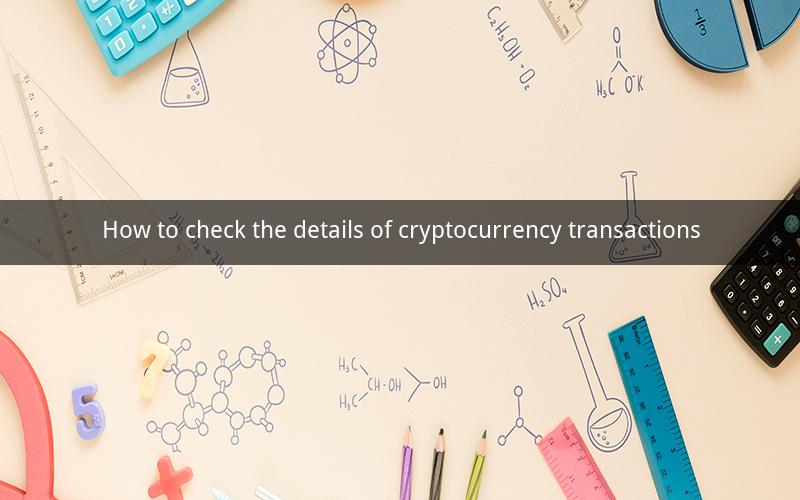
Table of Contents
1. Introduction to Cryptocurrency Transactions
2. Understanding Blockchain Technology
3. Importance of Checking Transaction Details
4. Steps to Check Cryptocurrency Transaction Details
4.1 Using Blockchain Explorer
4.2 Utilizing Cryptocurrency Wallets
4.3 Checking Transaction Details on Exchanges
5. Common Issues and Solutions
6. Best Practices for Ensuring Transaction Security
7. Conclusion
---
1. Introduction to Cryptocurrency Transactions
Cryptocurrency transactions have become increasingly popular in recent years, with more people investing in digital currencies like Bitcoin, Ethereum, and Litecoin. These transactions occur on a decentralized network called the blockchain, which ensures transparency and security. However, it is crucial to understand how to check the details of these transactions to ensure the safety of your investments.
2. Understanding Blockchain Technology
Blockchain technology is the backbone of cryptocurrency transactions. It is a decentralized ledger that records all transactions in a secure, immutable, and transparent manner. Each transaction is grouped into blocks, which are then linked together in a chain. This ensures that all transactions can be traced back to their origin, making it nearly impossible for fraudulent activities to occur.
3. Importance of Checking Transaction Details
Checking the details of cryptocurrency transactions is essential for several reasons:
- Ensuring the transaction is legitimate
- Verifying the transaction amount
- Confirming the transaction recipient
- Monitoring transaction history
- Protecting against fraud and theft
4. Steps to Check Cryptocurrency Transaction Details
To check the details of cryptocurrency transactions, follow these steps:
4.1 Using Blockchain Explorer
Blockchain explorers are online tools that allow users to view and verify transactions on a blockchain network. Here’s how to use them:
- Visit a blockchain explorer website, such as Blockchain.com or Etherscan.io.
- Enter the transaction hash or address you want to check.
- Review the transaction details, including the sender, recipient, amount, and timestamp.
4.2 Utilizing Cryptocurrency Wallets
Cryptocurrency wallets provide users with a convenient way to manage their digital assets. Many wallets also allow users to view transaction details:
- Open your cryptocurrency wallet.
- Navigate to the transaction history section.
- Select the transaction you want to check.
- Review the transaction details, including the sender, recipient, amount, and timestamp.
4.3 Checking Transaction Details on Exchanges
Cryptocurrency exchanges also provide users with the ability to check transaction details:
- Log in to your exchange account.
- Navigate to the transaction history section.
- Select the transaction you want to check.
- Review the transaction details, including the sender, recipient, amount, and timestamp.
5. Common Issues and Solutions
Some common issues that users may encounter when checking transaction details include:
- Transactions not showing up: This could be due to network congestion or a delay in updating the blockchain. Wait a few minutes and try again.
- Incorrect transaction details: Double-check the transaction hash or address you entered. Make sure you have the correct information.
- Failed transactions: This could be due to insufficient funds or a network error. Try sending the transaction again or contact customer support for assistance.
6. Best Practices for Ensuring Transaction Security
To ensure the security of your cryptocurrency transactions, follow these best practices:
- Use a strong, unique password for your cryptocurrency wallet and exchange accounts.
- Enable two-factor authentication (2FA) on your accounts.
- Keep your private keys secure and do not share them with anyone.
- Regularly update your software and use reputable security tools.
7. Conclusion
Checking the details of cryptocurrency transactions is essential for ensuring the security and legitimacy of your investments. By following the steps outlined in this article, you can easily verify transaction details and protect yourself against fraud and theft. Remember to always stay vigilant and follow best practices for maintaining the security of your digital assets.
---
Questions and Answers
1. Q: What is a blockchain explorer?
A: A blockchain explorer is an online tool that allows users to view and verify transactions on a blockchain network.
2. Q: How can I check the details of a cryptocurrency transaction?
A: You can use a blockchain explorer, cryptocurrency wallet, or exchange to check the details of a transaction.
3. Q: What should I do if a transaction doesn’t show up?
A: Wait a few minutes and try again. If the transaction still doesn’t show up, it may have failed.
4. Q: How can I ensure the security of my cryptocurrency transactions?
A: Use a strong password, enable 2FA, keep your private keys secure, and use reputable security tools.
5. Q: Can I reverse a cryptocurrency transaction?
A: No, cryptocurrency transactions are irreversible. Once a transaction is confirmed, it cannot be undone.
6. Q: What is a transaction hash?
A: A transaction hash is a unique identifier for a cryptocurrency transaction. It is a string of characters that can be used to verify the transaction.
7. Q: Can I track my cryptocurrency transactions?
A: Yes, you can track your cryptocurrency transactions using blockchain explorers, cryptocurrency wallets, and exchanges.
8. Q: What is the difference between a blockchain and a cryptocurrency?
A: A blockchain is a decentralized ledger that records transactions, while a cryptocurrency is a digital asset that is built on a blockchain.
9. Q: Can I use fiat currency to buy cryptocurrency?
A: Yes, many exchanges allow users to buy cryptocurrency using fiat currency.
10. Q: How long does it take for a cryptocurrency transaction to be confirmed?
A: The confirmation time for a cryptocurrency transaction varies depending on the network and the current level of network congestion.